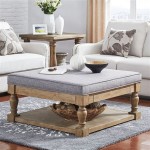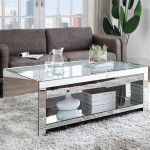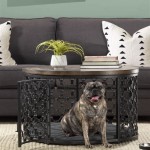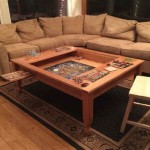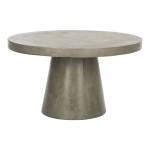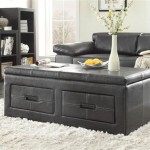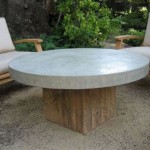Making The Most Out Of Coffee Table Seats
The coffee table, traditionally a low-lying surface intended to complement seating arrangements in living rooms, is undergoing a transformation. While maintaining its primary function as a place to rest beverages, books, and decorative items, the modern coffee table is increasingly incorporating seating options. This dual-purpose design, often referred to as a coffee table seat or ottoman coffee table, offers a versatile solution for optimizing space and enhancing functionality in various living environments.
Maximizing the potential of coffee table seats involves careful consideration of several factors, including design, functionality, material, space constraints, and aesthetic preferences. Successfully integrating these elements can result in a highly practical and visually appealing addition to any living space. The goal is to transform a simple piece of furniture into a multifaceted hub that caters to a range of needs, from casual relaxation to impromptu gatherings.
Understanding the Different Types of Coffee Table Seats
The market offers a diverse array of coffee table seats, each with its unique features and benefits. Understanding these variations is crucial for selecting the option that best suits individual needs and preferences. The primary distinctions lie in the design and construction of the seating components:
Ottoman Coffee Tables: These are perhaps the most common type of coffee table seat. Typically consisting of a cushioned surface atop a sturdy base, they offer comfortable seating while simultaneously serving as a coffee table. Some ottoman coffee tables feature a hinged top that reveals storage space inside, adding another layer of functionality to the piece. Materials can range from leather and fabric to wood and metal, allowing for seamless integration with existing décor.
Coffee Tables with Pull-Out Ottomans: This design incorporates small, individual ottomans that tuck neatly under the main coffee table when not in use. These ottomans can be easily pulled out to provide additional seating as needed and then stored away to maximize floor space. This is an excellent option for smaller living spaces where flexibility is paramount.
Coffee Tables with Integrated Benches: Certain coffee table designs feature integrated benches or cushioned platforms along the sides. These benches may be fixed or removable, depending on the design. They offer a more permanent seating solution compared to pull-out ottomans, providing a dedicated space for relaxation or conversation.
Convertible Coffee Tables: While not strictly coffee table seats, convertible coffee tables often incorporate seating as part of their expanded functionality. These tables can transform into larger dining tables or workstations, with seating options either built-in or designed to complement the expanded surface.
The selection process should involve a thorough assessment of the space available, the desired level of seating capacity, and the overall aesthetic of the room. Consider how frequently the extra seating will be used and whether the coffee table will primarily function as a seating area or a surface for other activities.
Key Considerations for Choosing Coffee Table Seats
Beyond the basic types, several key considerations influence the suitability and effectiveness of different coffee table seat options. These factors relate to comfort, durability, aesthetics, and overall functionality:
Comfort: The primary purpose of a seat is to provide comfort. The cushioning material, seat height, and overall design play crucial roles in determining the level of comfort offered. Opt for high-density foam or other supportive materials that will maintain their shape and provide adequate support over time. The seat height should be appropriate for comfortable interaction with the coffee table surface. If the coffee table is intended for dining or working, ensure that the seat height aligns with ergonomic principles. Consider the upholstery material. Leather offers durability and a sophisticated look, while fabric provides a softer, more inviting feel. Choose a material that is both comfortable to the touch and easy to clean.
Durability: A coffee table seat should be built to withstand regular use. The frame should be constructed from sturdy materials like hardwood or metal. The upholstery should be resistant to wear and tear, and the stitching should be reinforced. Pay attention to the weight capacity of the seating components. Ensure that they can comfortably support the weight of the intended users. Regularly inspect the coffee table seat for signs of wear and tear, and address any issues promptly to prevent further damage.
Aesthetics: The coffee table seat should complement the existing décor of the room. Consider the style, color, and texture of the other furniture pieces. Choose a coffee table seat that enhances the overall aesthetic of the space. The design should be both functional and visually appealing, creating a cohesive and inviting atmosphere. Pay attention to the details, such as the leg design, the upholstery pattern, and the hardware finishes. These small details can make a significant difference in the overall look and feel of the coffee table seat.
Functionality: The coffee table seat should serve its intended purpose effectively. Evaluate whether the seating is comfortable, durable, and aesthetically pleasing, but also consider how well it integrates with the other functions of the coffee table. Does it provide adequate surface space when the seating is not in use? Is it easy to clean and maintain? Does it offer any additional features, such as storage space? The ideal coffee table seat is one that seamlessly blends form and function, providing both seating and a convenient surface for everyday activities.
Space Constraints: Carefully assess the dimensions of the intended space before selecting a coffee table seat. Consider the size of the room, the placement of other furniture, and the available walking space. Choose a coffee table seat that fits comfortably in the room without overcrowding the space. Opt for a smaller, more compact design for smaller living spaces. In larger rooms, a larger coffee table seat with more seating capacity may be appropriate. Measure the dimensions of the room and the potential coffee table seat carefully to ensure a proper fit.
Incorporating Coffee Table Seats into Different Living Spaces
The versatility of coffee table seats allows them to be incorporated into various living spaces, each with unique requirements and design considerations. The successful integration of a coffee table seat depends on adapting its features to the specific characteristics of the room:
Small Apartments: In compact living spaces, maximizing every square inch is crucial. Coffee tables with pull-out ottomans or integrated storage offer an ideal solution. These designs provide additional seating without sacrificing valuable floor space. Choose light-colored upholstery and simple, streamlined designs to create a sense of openness and airiness. Consider a rectangular coffee table seat to optimize space along the length of a wall. Multi-functional coffee tables that can be used for dining, working, or relaxing are especially valuable in small apartments.
Family Rooms: Family rooms often require more seating to accommodate gatherings and activities. A large ottoman coffee table or a coffee table with integrated benches can provide ample seating for multiple people. Choose durable, easy-to-clean materials that can withstand the wear and tear of everyday use. Opt for darker colors or patterned upholstery to conceal stains and spills. Consider a coffee table seat with built-in storage to keep toys, blankets, and other items organized. The coffee table seat should be comfortable and inviting, creating a cozy atmosphere for family members to relax and spend time together.
Living Rooms: In formal living rooms, the aesthetic appeal of the coffee table seat is paramount. Choose a design that complements the existing décor and reflects the overall style of the room. Consider a leather ottoman coffee table with elegant details or a coffee table with integrated benches upholstered in a luxurious fabric. Pay attention to the proportions of the coffee table seat to ensure that it complements the other furniture pieces. The coffee table seat should be both functional and visually striking, adding a touch of sophistication to the living room.
Home Offices: While less common, incorporating a coffee table seat into a home office can provide a comfortable and versatile seating option for breaks or informal meetings. Choose a coffee table seat that is ergonomically designed and provides adequate support for extended periods of sitting. Consider a coffee table with a built-in power outlet or USB port for charging devices. The coffee table seat should be both functional and stylish, creating a comfortable and productive workspace.
By carefully considering these factors and tailoring the coffee table seat to the specific needs and characteristics of the space, individuals can maximize its functionality and create a more comfortable and inviting living environment. The coffee table seat should seamlessly integrate with the existing décor and serve as a valuable addition to the room.

How To Choose The Right Size Shape Coffee Table For Your Living Space

How To Choose The Right Size Shape Coffee Table For Your Living Space

How To Choose The Right Size Shape Coffee Table For Your Living Space

How To Choose The Right Size Shape Coffee Table For Your Living Space
:max_bytes(150000):strip_icc()/CarinaSkrobeckiPhoto_JessicaNelsonDesign_252222ndAve_01-47bc103d13e34f8d89179a86e968e7eb.jpg?strip=all)
12 Rules To Arrange Living Room Furniture

Basement Family Room Gets Even More Seating With A Sectional Nesting Grace

35 Charming Banquette Seating Ideas Kitchen Design

19 Small Dining Room Ideas And Decorating Tricks For 2025

How To Arrange Furniture In A Long Living Room 2025 Grace My Space

10 Living Room Interior Design Mistakes How To Fix Them
Related Posts

